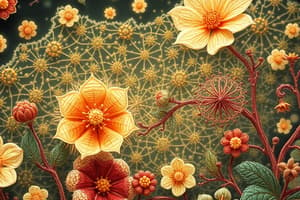Podcast
Questions and Answers
What type of cells are considered prokaryotic?
What type of cells are considered prokaryotic?
- Viruses and Viroids
- Bacteria and Archaea (correct)
- Fungi and Protists
- Animals and plants
All cells store their hereditary information using the same chemical code system.
All cells store their hereditary information using the same chemical code system.
True (A)
What is the primary energy source used by all cells?
What is the primary energy source used by all cells?
ATP
Cells are classified into two main types: ______ and ______.
Cells are classified into two main types: ______ and ______.
Match the following terms with their descriptions:
Match the following terms with their descriptions:
Which of the following cellular components is found in all cells?
Which of the following cellular components is found in all cells?
The binomial nomenclature system is used to classify species into three names.
The binomial nomenclature system is used to classify species into three names.
What process allows cells to replicate hereditary information?
What process allows cells to replicate hereditary information?
Which of the following structures is typically found in eukaryotic cells but not in prokaryotic cells?
Which of the following structures is typically found in eukaryotic cells but not in prokaryotic cells?
Prokaryotic cells have a true nucleus.
Prokaryotic cells have a true nucleus.
What type of cell division occurs in prokaryotic cells?
What type of cell division occurs in prokaryotic cells?
In eukaryotic cells, the DNA is usually _____ and associated with histones.
In eukaryotic cells, the DNA is usually _____ and associated with histones.
Match the type of cell with its characteristic:
Match the type of cell with its characteristic:
Which of the following is a function of the Golgi apparatus?
Which of the following is a function of the Golgi apparatus?
Chloroplasts are found in all eukaryotic cells.
Chloroplasts are found in all eukaryotic cells.
What are ribosomes primarily responsible for in the cell?
What are ribosomes primarily responsible for in the cell?
The cell wall of plant cells is primarily made of _____ and provides structural support.
The cell wall of plant cells is primarily made of _____ and provides structural support.
What type of process do prokaryotes use for genetic exchange?
What type of process do prokaryotes use for genetic exchange?
What did Robert Hooke observe in 1665 that led him to name them 'cellulae'?
What did Robert Hooke observe in 1665 that led him to name them 'cellulae'?
Cell theory states that all living organisms are made of cells.
Cell theory states that all living organisms are made of cells.
What is the smallest unit that retains the characteristics of life?
What is the smallest unit that retains the characteristics of life?
Schleiden proposed in 1838 that plant tissues are made of __________.
Schleiden proposed in 1838 that plant tissues are made of __________.
Match the scientists with their contributions to cell theory:
Match the scientists with their contributions to cell theory:
What is commonly known as mad cow disease?
What is commonly known as mad cow disease?
Prions have organelles and can replicate independently in a host organism.
Prions have organelles and can replicate independently in a host organism.
What type of disease is Creutzfeldt–Jakob disease (CJD)?
What type of disease is Creutzfeldt–Jakob disease (CJD)?
A virus consists of nucleic acid enclosed in a protein coat called a _______.
A virus consists of nucleic acid enclosed in a protein coat called a _______.
Match the following viruses with their characteristics:
Match the following viruses with their characteristics:
Which of the following is NOT a feature of viruses?
Which of the following is NOT a feature of viruses?
The time from the onset of symptoms to death in BSE is typically several years.
The time from the onset of symptoms to death in BSE is typically several years.
What is the primary function of the glycoproteins found in some viruses?
What is the primary function of the glycoproteins found in some viruses?
Prions can convert properly folded proteins into _______ form.
Prions can convert properly folded proteins into _______ form.
What type of genetic material might a virus contain?
What type of genetic material might a virus contain?
What is the primary method of preventing seasonal influenza?
What is the primary method of preventing seasonal influenza?
Influenza C virus infections are known to cause severe epidemics in humans.
Influenza C virus infections are known to cause severe epidemics in humans.
Name one of the two surface proteins that classify Influenza A viruses.
Name one of the two surface proteins that classify Influenza A viruses.
Influenza viruses are classified into four types: A, B, C, and ___ .
Influenza viruses are classified into four types: A, B, C, and ___ .
Match the type of influenza virus with its characteristic:
Match the type of influenza virus with its characteristic:
How many respiratory deaths are caused annually by seasonal influenza?
How many respiratory deaths are caused annually by seasonal influenza?
Seasonal influenza is an acute respiratory infection that can be treated effectively with antibiotics.
Seasonal influenza is an acute respiratory infection that can be treated effectively with antibiotics.
What factor contributes to a new influenza A virus causing a pandemic?
What factor contributes to a new influenza A virus causing a pandemic?
Influenza viruses can spread easily when infected individuals ___ .
Influenza viruses can spread easily when infected individuals ___ .
Which influenza virus has been known to primarily affect cattle?
Which influenza virus has been known to primarily affect cattle?
Flashcards
Cell Theory
Cell Theory
All living things are made of cells, cells are the basic unit of life, and all cells come from pre-existing cells.
Prokaryotic Cell
Prokaryotic Cell
A cell without a nucleus or other membrane-bound organelles, like bacteria and archaea.
Eukaryotic Cell
Eukaryotic Cell
A cell with a nucleus and other membrane-bound organelles, like plant and animal cells.
Cell Wall
Cell Wall
Signup and view all the flashcards
Plasma Membrane
Plasma Membrane
Signup and view all the flashcards
Ribosomes
Ribosomes
Signup and view all the flashcards
DNA
DNA
Signup and view all the flashcards
Mitochondria
Mitochondria
Signup and view all the flashcards
Nucleus
Nucleus
Signup and view all the flashcards
Endoplasmic Reticulum (ER)
Endoplasmic Reticulum (ER)
Signup and view all the flashcards
Golgi Apparatus
Golgi Apparatus
Signup and view all the flashcards
Binomial nomenclature
Binomial nomenclature
Signup and view all the flashcards
Virus
Virus
Signup and view all the flashcards
Prion
Prion
Signup and view all the flashcards
Study Notes
Universal Features of Cells
- Organisms on Earth reproduce, passing down hereditary information.
- All cells store their genetic information in DNA (or RNA for viruses).
- DNA/RNA codes (A, C, G, T or U) and their structures are universal.
- Protein synthesis and DNA replication occur similarly across species.
- All cells use proteins as catalysts.
- ATP is the energy source for all cells.
- All cells are enclosed within a plasma membrane.
- All cells contain ribosomes.
- Size, shape, and chemical requirements differentiate cells.
Taxonomy and Binomial Nomenclature
- Taxonomy classifies living things.
- Binomial nomenclature uses two names to give each species a unique scientific name.
Cell Types
- Prokaryotic Cells: Bacteria and Archaea
- Eukaryotic Cells: Protists, fungi, animals, plants
Prokaryotic vs Eukaryotic Cells
- Prokaryotic Cells:
- No nuclear membrane (nucleoid)
- No membrane-enclosed organelles
- Cell wall: Usually present, chemically complex
- Plasma membrane: No carbohydrates, lacks sterols
- Cytoplasm: Simpler cytoskeleton
- Ribosomes: Smaller in size (70S)
- Single circular DNA, lacks histones
- Cell division: Binary Division
- Sexual reproduction: No meiosis, only transfer of DNA fragments
- Eukaryotic Cells:
- True nucleus with a nuclear membrane
- Membrane-enclosed organelles like lysosomes, Golgi complex, ER, mitochondria, and chloroplasts
- Cell wall: When present, chemically simple
- Plasma membrane: Sterols & carbohydrates that serve as receptors
- Cytoplasm: Cytoskeleton, cytoplasmic streaming
- Ribosomes: Larger size (80S)
- Linear DNA with histones
- Cell division: Mitosis
- Sexual reproduction: Meiosis
Eukaryotic Cell Structure
- Nucleus:
- Contains the cell’s genetic material.
- Nuclear envelope surrounds the nucleus.
- Nucleolus is a nonmembranous structure involved in ribosome production.
- Chromatin: DNA and proteins, visible as chromosomes during cell division.
- Endoplasmic Reticulum (ER):
- Rough ER: Ribosome-studded, involved in protein synthesis.
- Smooth ER: No ribosomes, involved in lipid metabolism and detoxification.
- Golgi Apparatus:
- Processes, modifies, sorts, and secretes cell products.
- Mitochondria:
- Powerhouse of the cell, responsible for ATP production (cellular energy).
- Lysosomes:
- Digestive organelles for breakdown of waste products and macromolecules.
- Peroxisomes:
- Involved in detoxification and lipid metabolism.
- Ribosomes:
- Sites of protein synthesis, can be free in cytoplasm or bound to rough ER.
- Cytoskeleton:
- Network of protein filaments that provide structure and support for the cell.
- Includes: microfilaments, intermediate filaments, microtubules.
Plant Cell Structure
- Cell Wall: Outer layer, provides shape and protection, made of cellulose.
- Central Vacuole: Large, prominent in older cells, involved in waste breakdown and macromolecule storage.
- Chloroplasts: Photosynthetic organelles, convert light energy to chemical energy.
- Plasmodesmata: Cytoplasmic channels that connect neighboring cells.
Animal Cell Structure
- Centrioles: Involved in cell division.
- Plasma Membrane: Encloses the cell.
Plant vs Animal Cell Differences
- Cell Wall: Present in plants, absent in animals.
- Chloroplasts: Present in plants, absent in animals.
- Central Vacuole: Large and prominent in plant cells, smaller and less prominent in animals.
- Centrioles: Present in animals, absent in plants.
Prions
- Misfolded protein molecules that can propagate by transmitting a misfolded protein state.
- Induce correctly folded proteins to misfold.
- Example: Bovine spongiform encephalopathy (mad cow disease).
Viruses
- Infectious agents that replicate only inside living cells.
- Consist of nucleic acid (DNA or RNA) enclosed in a protein coat (capsid).
- Some viruses have a membranous envelope.
- No organelles, only genes.
- Example: Influenza viruses.
Influenza Viruses
- Cause seasonal epidemics of flu (flu season).
- Classified by subtypes based on hemagglutinin (HA) and neuraminidase (NA).
- HA binds to a virus receptor on the host cell.
- NA cleaves sialic acid from viral receptors.
Cell Theory
- All living organisms are composed of one or more cells.
- The cell is the basic living unit.
- All cells arise from preexisting cells.
Studying That Suits You
Use AI to generate personalized quizzes and flashcards to suit your learning preferences.
Related Documents
Description
This quiz covers the fundamental features of all cells, including their genetic information storage, protein synthesis, and energy sources. Additionally, it delves into the classification of living organisms through taxonomy and binomial nomenclature, as well as the distinctions between prokaryotic and eukaryotic cells.




